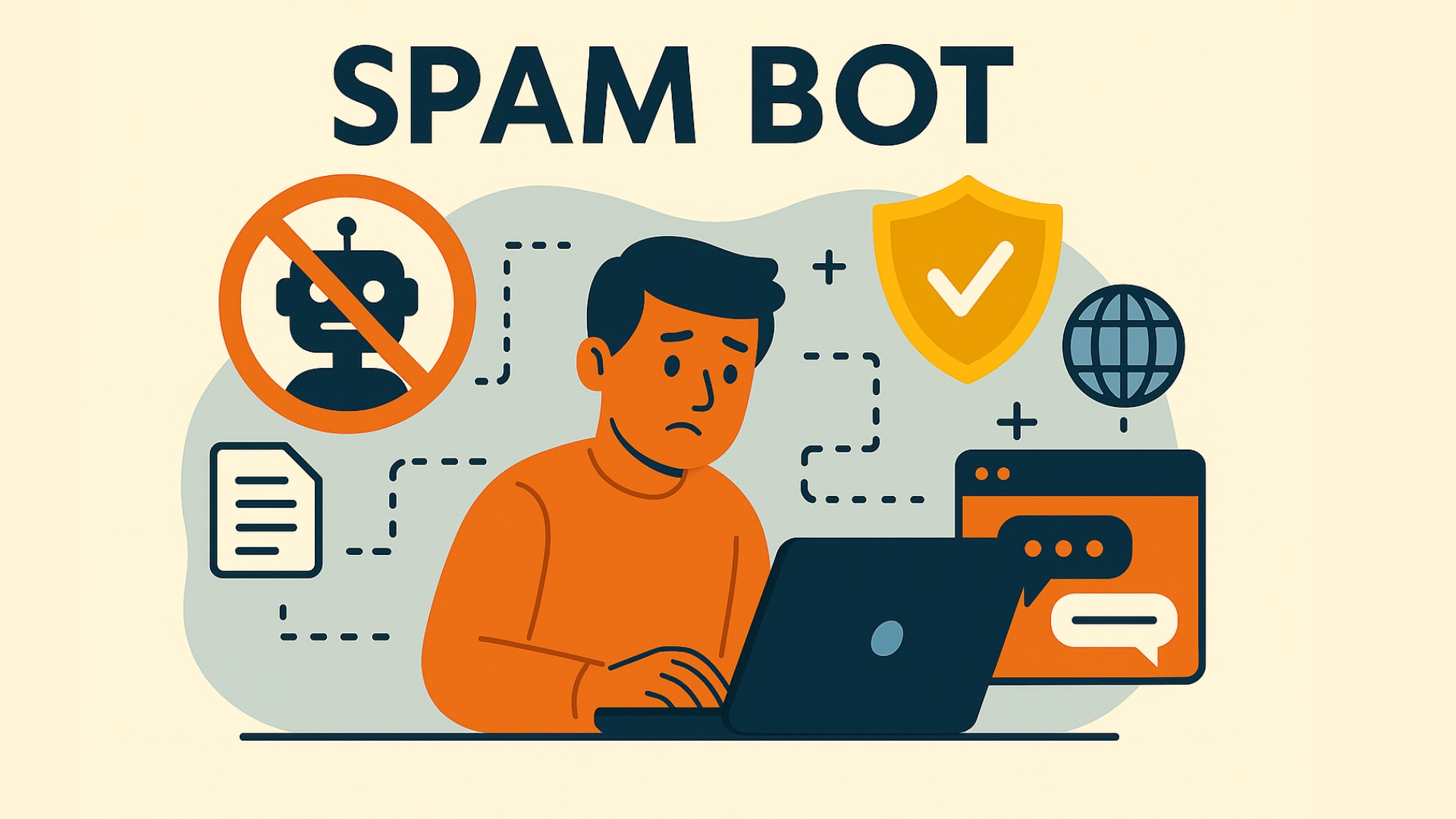
Spam bots are a significant and growing concern for businesses and users online. These automated programs are designed to send or assist in sending large volumes of unsolicited messages, often clogging up communication channels and creating major disruptions for both users and businesses. Whether it’s in the form of email spam, social media comments, or fake user accounts, spam bots operate tirelessly, without the need for human input. This article will explore the mechanics of spam bots, their risks, how to identify them and how businesses can protect themselves.
Table of contents
How do Spam Bots work?
Spam bots are designed to automate the sending of unsolicited messages in bulk. Their primary goal is to spam users with irrelevant content or malicious links. These bots use various tactics to create fake accounts, send messages and collect personal data. One of the primary functions of spam bots is to bypass security checks and interact with platforms in ways that mimic human behavior.
They start by creating fake accounts on platforms like social media, forums and email providers. Once the bot has an account, it begins to send spam messages or post unwanted content. Some are even programmed to assist spammers by collecting contact information, such as emails and phone numbers, which they use to build targeted lists for future spam campaigns.
Spam bots can also carry out scraping activities, scanning the internet for publicly available personal details to feed into further spam attacks. As attackers develop more sophisticated bots, many platforms are finding it harder to prevent their activities.
Where do Spam Bots occure?
Spam bots are pervasive across various online platforms. On social media, they send direct messages or post unsolicited promotions and offers. These bots may use fake accounts that appear legitimate or hijacked accounts from real users. Bots also like, share, or comment on posts to promote products, services, or irrelevant content.
In messaging apps, they try to coax users into sharing private information, sending money, or clicking harmful links. They may also serve as rudimentary chatbots, which try to engage users and guide them toward dangerous actions, such as revealing personal information.
On websites, spam bots are notorious for posting irrelevant or promotional comments in comment sections. These bots usually bypass registration processes or submit spam content on guest access. They often post links to external sites or use the comment section as a marketing channel, further spamming unrelated conversations.
Email spam remains one of the most common types of bot activity. They harvest email addresses and send out bulk messages, often disguised as legitimate offers. Many of these messages contain phishing attempts, scams, or links to malware downloads.
Threats and Risks of Spam Bots
Spam bots pose serious threats to both individuals and businesses. For individuals, they are often used in phishing attacks, attempting to trick people into disclosing sensitive data such as login credentials, credit card details, or social security numbers. Some of them also distribute malware through malicious links, which can infect devices and steal data.
For businesses, the risks are even more significant. Spam bots can severely impact website analytics and distort data, making it difficult to make informed business decisions. Bots interacting with advertising campaigns can waste marketing budgets by targeting fake users or inflating ad metrics. Additionally, they can harm a company’s reputation if they send unsolicited messages under the company’s name, leading to customer distrust.
Spam bots can also trigger service disruptions. By flooding systems with bot traffic, they can cause website slowdowns, affecting user experience and leading to financial losses. Furthermore, they can be used to exploit data breaches, using compromised accounts to launch more sophisticated attacks or gather sensitive corporate data.
How to Identify a Spam Bot?
Identifying spam bots involves looking for certain patterns and behaviors that set them apart from human users. They often make spelling and grammar mistakes in their messages, as they lack the natural conversational skills of humans. Offers that are too good to be true, such as unbelievable deals or urgent calls to action, are typical of spam bots trying to deceive users.
Spam bots also tend to pressure users into clicking links or taking immediate action. They may send irrelevant or out-of-context messages in comment sections or forums. The speed at which a message is posted or a form is filled can also be a clue. Human users usually take longer to complete actions, while they work in seconds.
Another sign of a spam bot is when conversations don’t make sense or deviate from the context. These bots follow rigid scripts, making it easy to spot them if their responses seem out of place.
Protection and Prevention of Spam Bots
Protecting your online presence from spam bots requires a multi-layered security approach. One of the most effective ways to block bots is by implementing CAPTCHA challenges. CAPTCHA systems are designed to distinguish between human users and bots, often requiring users to complete simple tasks that are difficult for automated systems.
Another key defense is IP blocking, which prevents known malicious IP addresses from accessing your website. Implementing rate limiting also helps by preventing too many requests from a single IP within a short time frame, making it more difficult for bots to flood your system.
Behavioral analysis tools can help identify suspicious bot activity by looking for patterns like rapid clicks or form submissions. Additionally, honeypots, which are hidden form fields that only bots can fill out, help catch them in the act.
For businesses handling sensitive data, it’s crucial to implement multi-factor authentication (MFA). This adds an extra layer of security by requiring users to verify their identity through another method, such as a code sent to their mobile device, reducing the effectiveness of spam bots attempting to gain unauthorized access.
Conclusion
A Spam bot is a persistent and evolving threat to online businesses. They can skew analytics, damage reputations and waste advertising budgets. However, implementing effective security measures, such as CAPTCHA, real-time monitoring and behavioral analysis, can help protect your website and users from these automated attacks.
For businesses seeking a privacy-compliant and user-friendly CAPTCHA solution, captcha.eu offers an ideal tool to distinguish between human visitors and spam bots. This helps ensure your website remains secure, efficient and trustworthy in the face of ever-evolving automated threats.
FAQ – Frequently Asked Questions
What is a spam bot?
A spam bot is an automated program used to send unsolicited messages or spam across various online platforms, including social media, email and website comment sections. They operate by mimicking human behavior to evade detection.
How do spam bots work?
Spam bots work by automating the process of sending or collecting spam. They often create fake accounts on websites, harvest contact information, and distribute unsolicited messages, usually for advertising, phishing, or malware purposes.
Where can spam bots operate?
Spam bots can be found on various platforms, including social media networks like Facebook and Instagram, email services, messaging apps, and website comment sections. They often use fake profiles or compromised real accounts to spread spam.
How do spam bots harm businesses?
Spam bots can harm businesses by skewing analytics, wasting advertising budgets, causing reputational damage, and even leading to data breaches. They may also cause a disruption in customer trust and service quality by overwhelming systems with fake activity.
How to identify a spam bot?
Spam bots often exhibit repetitive behavior such as sending similar messages, creating fake profiles, posting irrelevant content, or rapidly filling out forms. Suspicious behavior, including excessive speed or engagement with irrelevant content, can be a sign of bot activity.
How to protect against spam bots?
Businesses can protect themselves from spam bots by using services like captcha.eu, setting up email verification systems, limiting form submissions from a single IP and implementing robust firewall systems. Regular monitoring and updates to security measures help maintain a defense against evolving bot tactics.
100 free requests
You have the opportunity to test and try our product with 100 free requests.
If you have any questions
Contact us
Our support team is available to assist you.




